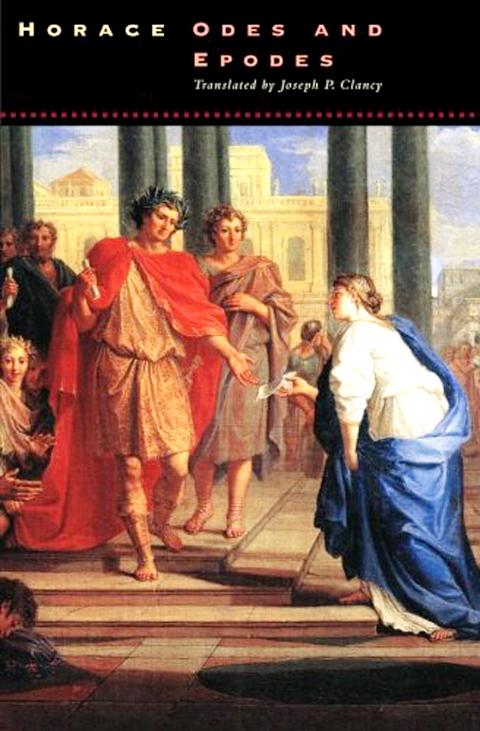Quintus Horatius Flaccus, known in English as Horace, has always been the best-loved Latin poet after Virgil. From the Renaissance to the beginning of the 20th century, there had been 90 translations of his Odes into English, and 100 into French. Robert Browning was made to learn all of them, in Latin, by heart as a boy. He remains the most imitated and enthused over Roman lyric poet there has ever been.
What are the reasons for this celebrity? The case against him would say that he symbolized gentlemanly breeding and good taste, and a slavish obedience to authority, and that he was forced down the throats of upper-class English students for centuries to produce in them just these qualities. Ezra Pound, despite making fine translations of some of his poems, described him as “bald-headed, pot-bellied, underbred, sycophantic.” After all, it was Horace who penned the words “Dulce et decorum est pro patria mori” (it is a sweet and fine thing to die for your country), dubbed by Wilfred Owen during the horrors of World War I as “the old lie.”
But even if some of this is true, Horace has the virtues of his shortcomings. He’s essentially urbane, tolerant, ironic and self-mocking. In Latin his poems are apparently miracles of ingenuity and technical sophistication, copying difficult Greek models. Virgil wrote his great epic about war, following in the footsteps of Homer, but Horace writes about country life on his estate, and frustrated love affairs. Yet whether writing about his patron, the rich nobleman Maecenas, or the ancient myths, he remains cool, detached and elegantly skeptical.

Virgil and Horace knew each other, and were both under the patronage of the emperor Augustus, being deemed exemplars of the greatness of the Latin language. Horace’s father, though, was a freed slave, and Horace was given his estate by Maecenas, probably at Augustus’s bidding. He was consequently able to devote his life to poetry, and is even reputed to have turned down the chance to become Augustus’s private secretary.
This Odes and Epodes of Horace contains translations dating back to 1960, but Chicago University Press has re-issued it, and in a very attractive cover. Joseph Clancy’s versions are characterized by modern colloquialisms within a framework of formal dexterity. They well deserve this re-appearance.
So what are some of Horace’s most famous poems? A.E. Housman, author of A Shropshire Lad (1896), and professor of Latin at Cambridge, thought Odes 1V.7 (beginning “Diffugere nives,” the snow has melted) was the most beautiful poem the Romans or Greeks ever produced, and translated it into English.
Then there’s Odes 1.11, finely rendered by Clancy, and which Pound also translated. It contains the famous phrase “carpe diem” (seize the day), well-known to all who remember Robin Williams and the 1989 film Dead Poets Society. The theme is an ancient one, that we only have this life, and it’s best to enjoy it while we can. Clancy memorably translates the concluding lines as follows:
Be sensible: strain the wine: in a little life, take no long looks ahead. As we talk, time spites us and runs: reap today: save no hopes for tomorrow.
Particularly famous, too, is Odes 1V.1, rendered with extreme power by Tom Stoppard as the closing effect of Act One of his 1997 play about Housman, The Invention of Love. Horace feels himself falling in love again, but protests to Venus that he’s too old for such wars. Horace, like so many Roman men, seems to have been essentially bi-sexual, and in this poem he’s fallen for a youth called Ligurinus. Clancy translates the ending strongly, but I prefer the version found in Stoppard:
At night I hold you fast in my dreams, I run after you across the Field of Mars, I follow you into the tumbling waters, and you show no pity.
Another poem, Odes 1.9, has found its way into history. Patrick Leigh Fermor translated it in his schooldays, and when during World War II he captured a German general on Crete, and the general quoted the opening words, Fermor was able to recite the whole poem in Latin to him. After this, captive and captor got on well.
Horace’s poems had been one of only three books Fermor took with him on his youthful walk across Europe, described in A Time of Gifts (1977) and its successors. “The whole point of Horace,” Fermor wrote, “is tautness and concentration and perfection.”
Byron also featured Odes 1.9 in his best-selling travel poem Childe Harold’s Pilgrimage (1812-1818). Horace’s poem describes Mount Soracte, north of Rome, and when Byron sees the mountain he immediately recalls his predecessor. The poet “whom I hated so” gave him no pleasure at school, he writes. “Then fare thee well – upon Soracte’s ridge we part.” But the fault, he admits, probably lay with his teachers.
For the rest, Swift imitated Odes 1.14, Odes 2.1 and Odes 3.2. Thackeray wrote a light-hearted parody of Odes 1.38 (an attack on Persian elegance), calling for an English leg of mutton for dinner rather than French truffles. Gladstone published a verse translation of all the odes in 1894, at the age of 85. Marvell’s Horatian Ode was inspired by Odes 1.37. Milton’s translation of Odes 1.5 is, according to The Classical Tradition (2010) “generally regarded as the worst rendition in English.”
What else? Shakespeare may well have been remembering Odes 3.30 when he wrote in Sonnet 55 “Not marble, nor the gilded monuments of princes, shall outlive this powerful rhyme.” Horace begins his ode “Exegi monumentum aere perennius,” which Clancy translates “My memorial is done: it will outlast bronze”.
And Keats was clearly remembering the start of Epode 14 when he wrote the opening of his Ode to a Nightingale. Clancy translates “Why has an easygoing slackness suffused all my senses with such a deep forgetfulness, as if my feverish lips had drunk to the dregs from the bowl that brings on the sleep of Lethe?” Keats wrote:
My heart aches, and a drowsy numbness pains
My sense, as though of hemlock I had drunk,
Or emptied some dull opiate to the drains
One minute past, and Lethe-wards had sunk.
Horace, then, remains indispensible. Tom Stoppard is probably the first English dramatist for 400 years who’s been able to move an audience to tears with words in Latin (previously carefully explained). And the words he quotes are Horace’s.

This year will go down in the history books. Taiwan faces enormous turmoil and uncertainty in the coming months. Which political parties are in a good position to handle big changes? All of the main parties are beset with challenges. Taking stock, this column examined the Taiwan People’s Party (TPP) (“Huang Kuo-chang’s choking the life out of the TPP,” May 28, page 12), the Democratic Progressive Party (DPP) (“Challenges amid choppy waters for the DPP,” June 14, page 12) and the Chinese Nationalist Party (KMT) (“KMT struggles to seize opportunities as ‘interesting times’ loom,” June 20, page 11). Times like these can

June 23 to June 29 After capturing the walled city of Hsinchu on June 22, 1895, the Japanese hoped to quickly push south and seize control of Taiwan’s entire west coast — but their advance was stalled for more than a month. Not only did local Hakka fighters continue to cause them headaches, resistance forces even attempted to retake the city three times. “We had planned to occupy Anping (Tainan) and Takao (Kaohsiung) as soon as possible, but ever since we took Hsinchu, nearby bandits proclaiming to be ‘righteous people’ (義民) have been destroying train tracks and electrical cables, and gathering in villages

Dr. Y. Tony Yang, Associate Dean of Health Policy and Population Science at George Washington University, argued last week in a piece for the Taipei Times about former president Ma Ying-jeou (馬英九) leading a student delegation to the People’s Republic of China (PRC) that, “The real question is not whether Ma’s visit helps or hurts Taiwan — it is why Taiwan lacks a sophisticated, multi-track approach to one of the most complex geopolitical relationships in the world” (“Ma’s Visit, DPP’s Blind Spot,” June 18, page 8). Yang contends that the Democratic Progressive Party (DPP) has a blind spot: “By treating any

Swooping low over the banks of a Nile River tributary, an aid flight run by retired American military officers released a stream of food-stuffed sacks over a town emptied by fighting in South Sudan, a country wracked by conflict. Last week’s air drop was the latest in a controversial development — private contracting firms led by former US intelligence officers and military veterans delivering aid to some of the world’s deadliest conflict zones, in operations organized with governments that are combatants in the conflicts. The moves are roiling the global aid community, which warns of a more militarized, politicized and profit-seeking trend